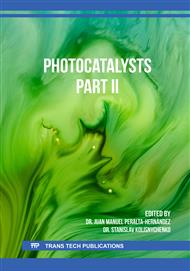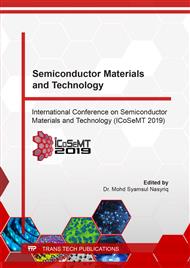[1]
Carneiro, P. A., Umbuzeiro, G. A., Oliveira, D. P., & Zanoni, M. V. B.. Assessment of water contamination caused by a mutagenic textile effluent/dyehouse effluent bearing disperse dyes. Journal of hazardous materials, 2010. 174(1-3), 694-699.
DOI: 10.1016/j.jhazmat.2009.09.106
Google Scholar
[2]
Khataee, A.R. and M.B. Kasiri, Photocatalytic degradation of organic dyes in the presence of nanostructured titanium dioxide: Influence of the chemical structure of dyes. Journal of Molecular Catalysis A: Chemical, 2010. 328(1): pp.8-26.
DOI: 10.1016/j.molcata.2010.05.023
Google Scholar
[3]
Garcia-Segura, S., F. Centellas, C. Arias, J.A. Garrido, R.M. Rodríguez, P.L. Cabot, and E. Brillas, Comparative decolorization of monoazo, diazo and triazo dyes by electro-Fenton process. Electrochimica Acta, 2011. 58: pp.303-311.
DOI: 10.1016/j.electacta.2011.09.049
Google Scholar
[4]
Neppolian, B., H.C. Choi, S. Sakthivel, B. Arabindoo, and V. Murugesan, Solar/UV-induced photocatalytic degradation of three commercial textile dyes. Journal of Hazardous Materials, 2002. 89(2): pp.303-317.
DOI: 10.1016/s0304-3894(01)00329-6
Google Scholar
[5]
Li, N., S. Tang, Y. Rao, J. Qi, Q. Zhang, and D. Yuan, Peroxymonosulfate enhanced antibiotic removal and synchronous electricity generation in a photocatalytic fuel cell. Electrochimica Acta, 2019. 298: pp.59-69.
DOI: 10.1016/j.electacta.2018.12.063
Google Scholar
[6]
Bai, J., R. Wang, Y. Li, Y. Tang, Q. Zeng, L. Xia, X. Li, J. Li, C. Li, and B. Zhou, A solar light driven dual photoelectrode photocatalytic fuel cell (PFC) for simultaneous wastewater treatment and electricity generation. Journal of Hazardous Materials, 2016. 311: pp.51-62.
DOI: 10.1016/j.jhazmat.2016.02.052
Google Scholar
[7]
Li, K., Y. Xu, Y. He, C. Yang, Y. Wang, and J. Jia, Photocatalytic fuel cell (PFC) and dye self-photosensitization photocatalytic fuel cell (DSPFC) with BiOCl/Ti photoanode under UV and visible light irradiation. Environmental Science & Technology, 2013. 47(7): pp.3490-3497.
DOI: 10.1021/es303968n
Google Scholar
[8]
Xie, S. and K. Ouyang, Degradation of refractory organic compounds by photocatalytic fuel cell with solar responsive WO3/FTO photoanode and air-breathing cathode. Journal of Colloid and Interface Science, 2017. 500: pp.220-227.
DOI: 10.1016/j.jcis.2017.04.002
Google Scholar
[9]
Xie, S., K. Ouyang, and Y. Shao, A solar responsive photocatalytic fuel cell with a heterostructured ZnFe2O4/TiO2-NTs photoanode and an air-breathing cathode. International Journal of Hydrogen Energy, 2017. 42(49): pp.29201-29209.
DOI: 10.1016/j.ijhydene.2017.10.059
Google Scholar
[10]
Lee, S.-L., L.-N. Ho, S.-A. Ong, Y.-S. Wong, C.-H. Voon, W.F. Khalik, N.A. Yusoff, and N. Nordin, A highly efficient immobilized ZnO/Zn photoanode for degradation of azo dye Reactive Green 19 in a photocatalytic fuel cell. Chemosphere, 2017. 166: pp.118-125.
DOI: 10.1016/j.chemosphere.2016.09.082
Google Scholar
[11]
Xia, M., R. Chen, X. Zhu, Q. Liao, L. An, Z. Wang, X. He, and L. Jiao, A micro photocatalytic fuel cell with an air-breathing, membraneless and monolithic design. Science Bulletin, 2016. 61(21): pp.1699-1710.
DOI: 10.1007/s11434-016-1178-8
Google Scholar
[12]
Zhao, K., J. Bai, Q. Zeng, Y. Zhang, J. Li, L. Li, L. Xia, and B. Zhou, Efficient wastewater treatment and simultaneously electricity production using a photocatalytic fuel cell based on the radical chain reactions initiated by dual photoelectrodes. Journal of Hazardous Materials, 2017. 337: pp.47-54.
DOI: 10.1016/j.jhazmat.2017.05.004
Google Scholar
[13]
Liu, Y., J. Li, B. Zhou, X. Li, H. Chen, Q. Chen, Z. Wang, L. Li, J. Wang, and W. Cai, Efficient electricity production and simultaneously wastewater treatment via a high-performance photocatalytic fuel cell. Water Research, 2011. 45(13): pp.3991-3998.
DOI: 10.1016/j.watres.2011.05.004
Google Scholar
[14]
Li, J., J. Li, Q. Chen, J. Bai, and B. Zhou, Converting hazardous organics into clean energy using a solar responsive dual photoelectrode photocatalytic fuel cell. Journal of hazardous materials, 2013. 262: pp.304-310.
DOI: 10.1016/j.jhazmat.2013.08.066
Google Scholar
[15]
Nahyoon, N.A., L. Liu, K. Rabe, K.H. Thebo, L. Yuan, J. Sun, and F. Yang, Significant photocatalytic degradation and electricity generation in the photocatalytic fuel cell (PFC) using novel anodic nanocomposite of Fe, graphene oxide, and titanium phosphate. Electrochimica Acta, 2018. 271: pp.41-48.
DOI: 10.1016/j.electacta.2018.03.109
Google Scholar
[16]
Liao, Q., L. Li, R. Chen, X. Zhu, H. Wang, D. Ye, X. Cheng, M. Zhang, and Y. Zhou, Respective electrode potential characteristics of photocatalytic fuel cell with visible-light responsive photoanode and air-breathing cathode. International Journal of Hydrogen Energy, 2015. 40(46): pp.16547-16555.
DOI: 10.1016/j.ijhydene.2015.10.002
Google Scholar
[17]
Bizarro, M., A. Sánchez-Arzate, I. Garduño-Wilches, J.C. Alonso, and A. Ortiz, Synthesis and characterization of ZnO and ZnO:Al by spray pyrolysis with high photocatalytic properties. Catalysis Today, 2011. 166(1): pp.129-134.
DOI: 10.1016/j.cattod.2010.08.005
Google Scholar
[18]
Ghaly, M.Y., M.E.M. Ali, L. Österlund, I.A. Khattab, M.I. Badawy, J.Y. Farah, F.M. Zaher, and M.N. Al-Maghrabi, ZnO/spiral-shaped glass for solar photocatalytic oxidation of Reactive Red 120. Arabian Journal of Chemistry, 2017. 10: p. S3501-S3507.
DOI: 10.1016/j.arabjc.2014.02.015
Google Scholar
[19]
Lee, S.-L., L.-N. Ho, S.-A. Ong, Y.-S. Wong, C.-H. Voon, W.F. Khalik, N.A. Yusoff, and N. Nordin, Enhanced electricity generation and degradation of the azo dye Reactive Green 19 in a photocatalytic fuel cell using ZnO/Zn as the photoanode. Journal of Cleaner Production, 2016. 127: pp.579-584.
DOI: 10.1016/j.jclepro.2016.03.169
Google Scholar
[20]
Khalik, W.F., L.-N. Ho, S.-A. Ong, Y.-S. Wong, N.A. Yusoff, and F. Ridwan, Decolorization and mineralization of batik wastewater through solar photocatalytic process. Sains Malaysiana, 2015. 44(4): pp.607-612.
DOI: 10.17576/jsm-2015-4404-16
Google Scholar
[21]
Ong, Y.-P., L.-N. Ho, S.-A. Ong, J. Banjuraizah, A.H. Ibrahim, S.-L. Lee, and N. Nordin, A synergistic heterostructured ZnO/BaTiO3 loaded carbon photoanode in photocatalytic fuel cell for degradation of Reactive Red 120 and electricity generation. Chemosphere, 2019. 219: pp.277-285.
DOI: 10.1016/j.chemosphere.2018.12.004
Google Scholar
[22]
Guillard, C., H. Lachheb, A. Houas, M. Ksibi, E. Elaloui, and J.-M. Herrmann, Influence of chemical structure of dyes, of pH and of inorganic salts on their photocatalytic degradation by TiO2 comparison of the efficiency of powder and supported TiO2. Journal of Photochemistry and Photobiology A: Chemistry, 2003. 158(1): pp.27-36.
DOI: 10.1016/s1010-6030(03)00016-9
Google Scholar
[23]
Hsueh, C.-C. and B.-Y. Chen, Comparative study on reaction selectivity of azo dye decolorization by Pseudomonas luteola. Journal of Hazardous Materials, 2007. 141(3): pp.842-849.
DOI: 10.1016/j.jhazmat.2006.07.056
Google Scholar
[24]
Wu, C.-H., Comparison of azo dye degradation efficiency using UV/single semiconductor and UV/coupled semiconductor systems. Chemosphere, 2004. 57(7): pp.601-608.
DOI: 10.1016/j.chemosphere.2004.07.008
Google Scholar
[25]
Khataee, A.R., M.N. Pons, and O. Zahraa, Photocatalytic degradation of three azo dyes using immobilized TiO2 nanoparticles on glass plates activated by UV light irradiation: Influence of dye molecular structure. Journal of Hazardous Materials, 2009. 168(1): pp.451-457.
DOI: 10.1016/j.jhazmat.2009.02.052
Google Scholar
[26]
Damodar, R.A., K. Jagannathan, and T. Swaminathan, Decolourization of reactive dyes by thin film immobilized surface photoreactor using solar irradiation. Solar Energy, 2007. 81(1): pp.1-7.
DOI: 10.1016/j.solener.2006.07.001
Google Scholar
[27]
Lianos, P., Production of electricity and hydrogen by photocatalytic degradation of organic wastes in a photoelectrochemical cell: the concept of the photofuelcell: a review of a re-emerging research field. Journal of Hazardous Materials, 2011. 185(2-3): pp.575-590.
DOI: 10.1016/j.jhazmat.2010.10.083
Google Scholar
[28]
Kamat, P.V. and D. Meisel, Nanoparticles in advanced oxidation processes. Current Opinion in Colloid & Interface Science, 2002. 7(5-6): pp.282-287.
DOI: 10.1016/s1359-0294(02)00069-9
Google Scholar
[29]
Li, K., H. Zhang, T. Tang, Y. Xu, D. Ying, Y. Wang, and J. Jia, Optimization and application of TiO2/Ti–Pt photo fuel cell (PFC) to effectively generate electricity and degrade organic pollutants simultaneously. Water Research, 2014. 62: pp.1-10.
DOI: 10.1016/j.watres.2014.05.044
Google Scholar



